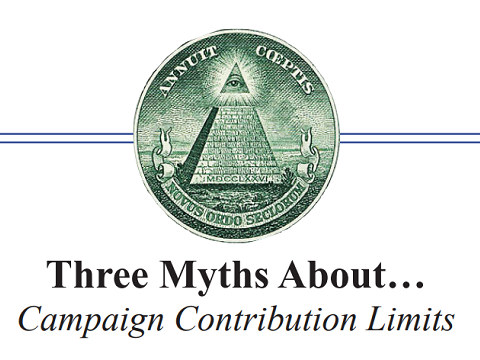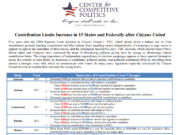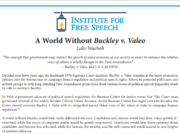Forty-five of the 50 states and the federal government in some way impose limits on the amount individuals or groups can contribute to the campaigns of their preferred candidates. Here’s the reality behind three common myths often asserted
about contribution limits:
Myth #1: Contribution limits prevent corruption.
FALSE. The Institute for Free Speech compared all 50 states’ contribution limits on individuals to public corruption data and found no relationship between the existence of contribution limits and corruption levels. In fact, states with no or high contribution limits are statistically more likely to have low corruption rates than states with more restrictive limits.1
Myth #2: Contribution limits improve the quality of governance.
FALSE. After comparing U.S. News & World Report’s ranking of all 50 states on the quality of their governance with each state’s contribution limits on individual giving to legislative candidates, we found the opposite. Five out of the top-10 ranked states allow unlimited contributions from individuals to statewide and state legislative candidates (Indiana, Virginia, Utah, North Dakota, and Iowa).2
Myth #3: Contribution limits curb the legislative influence of corporations, labor unions, and wealthy donors.
FALSE. Political scientists have found that “campaign contributions had no statistically significant effects on legislation….”3
Faced with limits on campaign contributions, many donors will opt to give to independent groups like super PACs instead.
THE VERDICT: While also failing to achieve their intended goals, ultimately contribution limits restrict the freedom of citizens to contribute to the candidates and causes of their choice. More information on how to access the research described above is available on the back of this brief.
Further Reading
1 Joe Albanese, “Do Lower Contribution Limits Decrease Public Corruption?,” Institute for Free Speech. Available at: https://www.ifs.org/wp-content/uploads/2013/08/2017-07-01_Issue-Analysis-5_Albanese_Do-LowerContribution-Limits-Decrease-Public-Corruption.pdf (July 2017).
2 Joe Albanese, “Do Lower Contribution Limits Produce ‘Good’ Government?,” Institute for Free Speech. Available at: https://www.ifs.org/wp-content/uploads/2013/10/2017-07-01_Issue-Analysis-6_Albanese_Do-LowerContribution-Limits-Produce-Good-Government.pdf (July 2017).
3 Stephen Ansolabehere, John de Figueiredo, and James M. Snyder Jr., “Why is There so Little Money in U.S. Politics?,” The Journal of Economic Perspectives Vol.17, No. 1 (Winter 2003), p. 17.














